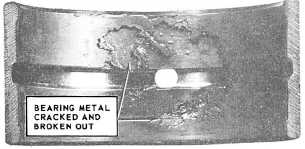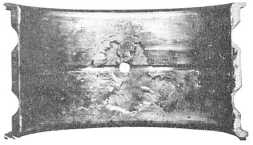ENGINEMAN 1 & C
This is generally the result of very close oil
clearances and the use of an oil having a viscos-
ity higher than recommended. Early stages of the
loss of lead, due to melting, will be evidenced by
very small streaks of lead on the bearing surface.
loads on the main bearings because of the force
that is necessary to retain correct alignment be-
tween the bearing and the journal.
3. Inadequate bond between the bearing metal
and the bearing shell. A poor bond may be
caused by fatigue resulting from cyclic loads, or
it may be the result of defective manufacturing.
A failure due to inadequate bond is shown in
figure 3-20. In such failures, the bearing shell
shows through the bearing surface clearly.
A bent or misaligned connecting rod can be
the cause of a ruined crank-pin bearing. Misalign-
ment between the connecting rod bore and the
piston pin bushing bore is indicated by the crack-
ing of the bearing material at the opposite ends
of the upper and lower-bearing shell. An indica-
tion of a bent connecting rod is heavy wear or
scoring on the piston surface.
4. Out-of-round journals due to excessive
bearing wear. As the bearings wear, excessive
clearance is created; this leads to engine pounding,
oil leakage from the bearing, reduced flow of oil
to other bearings, and overheating, with the con-
sequent melting of bearing material. To prevent
bearing wear, the journals should be checked for
out-of-roundness. Manufacturers require crank
pins to be reground when the out-of-roundness
exceeds a specified amount, but the amount varies
with manufacturers. Always check the engine
manual for this type of data.
5. Rough spots. Burrs or ridges may cause
grooves in the bearings and lead to bearing failure.
Removal of rough spots is done with a fine oil
stone and a piece of crocus cloth. Be sure to place
a clean cloth beneath the journal to catch all par-
ticles. Apply a coat of clean lubricating oil to the
journal and to the bearing before a bearing is
installed.
7. Faulty installation, due to negligence or
lack of experience. The paramount factor is
inattention to cleanliness. Hard particles lodge
between the bearing shell and the connecting rod
bore, and create an air space. This space retards
the normal flow of heat and causes localized high
temperatures. Such condition may be further ag-
gravated if the bearing surface is forced out into
the oil clearance spaces and creates a high spot
in the bearing surface. The result of a bearing
failure is illustrated in figure 3-21. Foreign par-
ticles, excessive clearance, or rough surface may
cause poor contact between a bearing shell and
a connecting rod. Poor contact is indicated by the
formation of a gumlike deposit (sometimes re-
ferred to as lacquer or varnish) on the back of
the shell.
6. Misalignment of parts. Misalignment of the
main bearings can be caused by a warped or bent
crankshaft. Such misalignment imposes heavy
Bearing failures may result from improper fit
of the shell to the connecting rod. If the locking
lip of a bearing does not fit properly into the recess
of the bearing housing, distortion of the shell and
failure of the bearing results.
121.5
121.4
Figure 3-20.—Bearing failure due to inadequate bond.
Figure 3-21.—Bearing failure resulting from wiping and
excessive temperatures.
3-34




